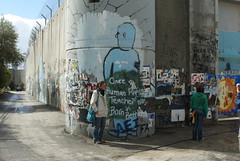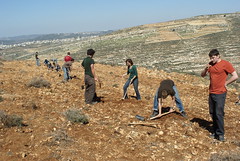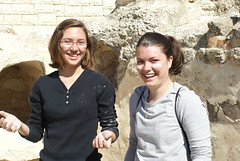 This past week we have been staying at Jerusalem University College (JUC) and begun studying Biblical geography, history, and archaeology. The transition from Palestine to Israel has been tough for me, but JUC is a wonderful place to be staying and I wish we could be here for more than two weeks. The JUC campus is beautiful and we have enjoyed meeting the students who are here for the semester. The purpose of our time here is to begin to understand the way the land of Israel influenced the Biblical story and the people who inhabited the land. In the first week we explored around Jerusalem, including the original City of David, Hezekiah’s tunnel, the Mount of Olives, and Mount Scopus. We also traveled to places like Shiloh, Beer-Sheva, Arad, Madaba, Qumran, En Gedi, Ashkelon, Azekah, and Beth-Shemesh… the list could go on. The volume of information we have been given is overwhelming.
This past week we have been staying at Jerusalem University College (JUC) and begun studying Biblical geography, history, and archaeology. The transition from Palestine to Israel has been tough for me, but JUC is a wonderful place to be staying and I wish we could be here for more than two weeks. The JUC campus is beautiful and we have enjoyed meeting the students who are here for the semester. The purpose of our time here is to begin to understand the way the land of Israel influenced the Biblical story and the people who inhabited the land. In the first week we explored around Jerusalem, including the original City of David, Hezekiah’s tunnel, the Mount of Olives, and Mount Scopus. We also traveled to places like Shiloh, Beer-Sheva, Arad, Madaba, Qumran, En Gedi, Ashkelon, Azekah, and Beth-Shemesh… the list could go on. The volume of information we have been given is overwhelming.
The first day we arrived in Jerusalem was my birthday (as well as Jamila’s – it was awesome to get to celebrate our birthdays together!). That Sunday, I woke up in Beit Sahour and realized that about 2000 years ago Jesus was born within five miles of my house.
I have been trying to understand the significance of this – that I celebrated my birthday in the land of Jesus’ birth. On that day I saw Bethlehem and Jerusalem, where Christ was born and where he died. I am starting to realize how importance the incarnation is to my faith; how important it is to me that I could have met God on the road to Jerusalem, that he walked in the Judean hills, that he might have known the burn of muscles from hiking through Wadi Qelt. Being in this land that for some reason is important in a real, eternal, mystical, crazy way to the story of humanity  and God and redemption and love and life – being here is making me love the incarnation. It makes me love that Jesus had a body that probably ached at the end of long days (maybe he helped clear fields of rocks like I did at Tent of Nations; maybe he helped his father plant some grape vines like I did that day). I love that Jesus lived in a place with thorns and that he didn’t shy away from pain. I love that I can envision my savior with the dark hair and expressive eyes of the people who live here; that when I pass an Arab man on the street I can think maybe Jesus looked like that. I have found a piece of a crazy, hard, strange religion that I love and this helps me understand the weird parts (like, for example, the story about the Benjaminites’ wife-snatching that we read at Shiloh).
and God and redemption and love and life – being here is making me love the incarnation. It makes me love that Jesus had a body that probably ached at the end of long days (maybe he helped clear fields of rocks like I did at Tent of Nations; maybe he helped his father plant some grape vines like I did that day). I love that Jesus lived in a place with thorns and that he didn’t shy away from pain. I love that I can envision my savior with the dark hair and expressive eyes of the people who live here; that when I pass an Arab man on the street I can think maybe Jesus looked like that. I have found a piece of a crazy, hard, strange religion that I love and this helps me understand the weird parts (like, for example, the story about the Benjaminites’ wife-snatching that we read at Shiloh).
It is so good to be able to read passages from the Bible in this land – especially after visiting Qumran, where the Dead Sea Scrolls were discovered. We read the story of Samuel at Shiloh, about David and Goliath at Azekah, and Christ before the crucifixion on the Mount of Olives. I think I can speak for our whole group when I say that whatever our faith looked like when we first drove into Jerusalem, we will leave changed.
A few other interesting things: we got to see the Stutzman’s boat SailingActs in Ashkelon, we were able to swim in the Dead Sea, we’ve been seeing military people everywhere, and our bus broke down one afternoon. One final thought: as we enter into the second half of our traveling and some of us are growing weary of continually packing our things up and moving out, I find it meaningful to think about how in the Bible, from Abraham to Paul, God seems to be especially present in the lives of those people who are consistently on the move.
-Emily Harnish
 I cannot describe what I felt. I can only describe what I saw. Jesus’ town, Capernaum, nestled along the shore of the lake. Big rocks he might have envisioned building with, water he might have splashed in. A rainbow appeared and birds flew past as I watched the waves creating spots of white water across the lake. A scene he might have enjoyed on a winter afternoon on the shore of the Sea of Galilee, remembering the rainbow’s promise. I walked through the ruins of the synagogue. Jesus was here! And then the courtyard, stone floor and open space, the deep carvings of lines in the ground where the children played games as their parents prayed. Jesus taught here. He spent time here. I looked over the village, the stone houses built together with common walls, like city rowhouses almost. Which one was his? My eyes rested on one close to a synagogue entryway. Maybe. Again I scanned the village, looking at the basalt stones in place upon each wall. How many of these did he touch? How many did he himself- the builder- put into place? Inside each house lived a family, a family he interacted with, visited, fixed things for. My Jesus lived here. This was his chosen home base.
I cannot describe what I felt. I can only describe what I saw. Jesus’ town, Capernaum, nestled along the shore of the lake. Big rocks he might have envisioned building with, water he might have splashed in. A rainbow appeared and birds flew past as I watched the waves creating spots of white water across the lake. A scene he might have enjoyed on a winter afternoon on the shore of the Sea of Galilee, remembering the rainbow’s promise. I walked through the ruins of the synagogue. Jesus was here! And then the courtyard, stone floor and open space, the deep carvings of lines in the ground where the children played games as their parents prayed. Jesus taught here. He spent time here. I looked over the village, the stone houses built together with common walls, like city rowhouses almost. Which one was his? My eyes rested on one close to a synagogue entryway. Maybe. Again I scanned the village, looking at the basalt stones in place upon each wall. How many of these did he touch? How many did he himself- the builder- put into place? Inside each house lived a family, a family he interacted with, visited, fixed things for. My Jesus lived here. This was his chosen home base.
This past week in our field studies at JUC, I saw Jesus in a completely new light. Learning the context and how some of the things we have come to take for granted might be imprecise translations has completely changed my idea of who Jesus was. His life seems so much more concrete and real now. So much more realistic. Easier to imitate, even. After learning so much about the context of the Bible, I now look forward to reading it again with new insight. The last two weeks were intense, but definitely worth it! And now we get to enjoy free travel.
–Jamila Witmer